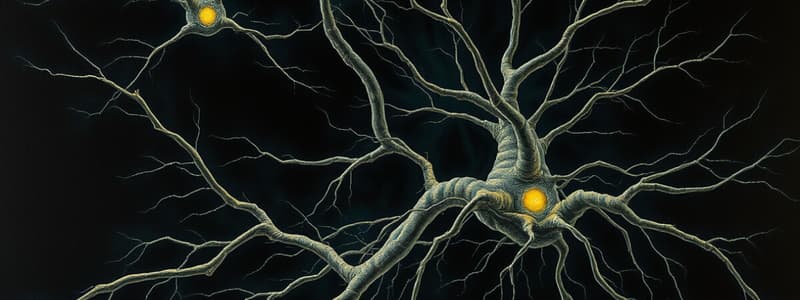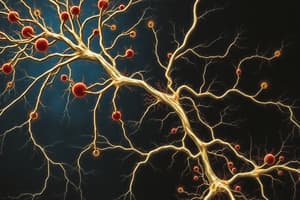Podcast
Questions and Answers
What is the primary function of the cerebrum?
What is the primary function of the cerebrum?
- Controlling basic life functions
- Maintaining posture and balance
- Coordinating voluntary movements
- Managing higher brain functions (correct)
Which disorder is characterized by the degeneration of dopamine-producing neurons?
Which disorder is characterized by the degeneration of dopamine-producing neurons?
- Multiple Sclerosis
- Parkinson's Disease (correct)
- Epilepsy
- Alzheimer's Disease
What role does the brainstem play in the nervous system?
What role does the brainstem play in the nervous system?
- Enhancing cognitive abilities
- Controlling basic life functions (correct)
- Regulating emotions and thought processes
- Facilitating motor skills
Which condition involves the immune system attacking the protective covering of nerves?
Which condition involves the immune system attacking the protective covering of nerves?
What is an essential function of the nervous system?
What is an essential function of the nervous system?
What makes up the Central Nervous System (CNS)?
What makes up the Central Nervous System (CNS)?
Which part of the nervous system controls voluntary movements?
Which part of the nervous system controls voluntary movements?
What role do neurotransmitters play in the nervous system?
What role do neurotransmitters play in the nervous system?
Which of the following is NOT a function of the nervous system?
Which of the following is NOT a function of the nervous system?
Which part of the autonomic nervous system is responsible for 'rest and digest' activities?
Which part of the autonomic nervous system is responsible for 'rest and digest' activities?
What structures protect the Central Nervous System?
What structures protect the Central Nervous System?
Which neurotransmitter is primarily involved in muscle movement and memory?
Which neurotransmitter is primarily involved in muscle movement and memory?
What is the main function of the dendrites in a neuron?
What is the main function of the dendrites in a neuron?
Flashcards are hidden until you start studying
Study Notes
Nervous System Overview
- The nervous system is a complex network that transmits signals between different parts of the body.
- It coordinates voluntary and involuntary actions and processes sensory information.
Main Components
-
Central Nervous System (CNS)
- Comprises the brain and spinal cord.
- Responsible for processing information and controlling responses.
-
Peripheral Nervous System (PNS)
- Connects the CNS to the rest of the body.
- Divided into:
- Somatic Nervous System: Controls voluntary movements and transmits sensory information.
- Autonomic Nervous System: Regulates involuntary functions (e.g., heart rate, digestion).
- Further divided into:
- Sympathetic Nervous System: Prepares the body for 'fight or flight' response.
- Parasympathetic Nervous System: Promotes 'rest and digest' activities.
- Further divided into:
Neurons
- Basic functional units of the nervous system.
- Structure:
- Dendrites: Receive signals from other neurons.
- Cell body (soma): Contains the nucleus and organelles.
- Axon: Transmits signals away from the cell body.
- Synapse: Junction between two neurons where neurotransmitters are released.
Neurotransmitters
- Chemical messengers that transmit signals across synapses.
- Examples:
- Acetylcholine: Involved in muscle movement and memory.
- Dopamine: Associated with pleasure and reward.
- Serotonin: Regulates mood and sleep.
Functions of the Nervous System
- Sensory Input: Receives stimuli from the environment (e.g., light, sound).
- Integration: Processes and interprets sensory information.
- Motor Output: Initiates responses (e.g., muscle contraction).
Protective Structures
- Skull and vertebrae: Bony structures that encase the brain and spinal cord.
- Meninges: Three layers of membranes (dura mater, arachnoid mater, pia mater) that cover the CNS.
- Cerebrospinal Fluid (CSF): Cushions the brain and spinal cord, providing buoyancy and protection.
Brain Regions
- Cerebrum: Largest part, responsible for higher brain functions (thought, emotion, memory).
- Cerebellum: Coordinates voluntary movements and maintains posture and balance.
- Brainstem: Controls basic life functions (breathing, heartbeat, blood pressure).
Disorders of the Nervous System
- Parkinson's Disease: Degeneration of neurons in the dopamine-producing areas of the brain.
- Multiple Sclerosis: Immune system attacks the protective covering of nerves.
- Alzheimer's Disease: Progressive neurodegeneration affecting memory and cognitive functions.
Conclusion
- The nervous system is essential for survival, enabling interaction with the environment, coordination of bodily functions, and response to stimuli. Understanding its structure and functions is crucial for recognizing its role in health and disease.
Nervous System Overview
- A complex communication network that conveys signals throughout the body.
- Coordinates both voluntary and involuntary actions while processing sensory inputs.
Main Components
-
Central Nervous System (CNS)
- Includes the brain and spinal cord.
- Main role: Information processing and response control.
-
Peripheral Nervous System (PNS)
- Links the CNS to the rest of the body.
- Divided into two main systems:
- Somatic Nervous System: Governs voluntary movements; transmits sensory data.
- Autonomic Nervous System: Manages involuntary functions like heart rate and digestion.
- Sympathetic Nervous System: Activates 'fight or flight' responses.
- Parasympathetic Nervous System: Encourages 'rest and digest' functions.
Neurons
- Fundamental units of the nervous system responsible for signal transmission.
- Key Structures:
- Dendrites: Receive incoming signals from other neurons.
- Cell body (soma): Houses the nucleus and cellular organelles.
- Axon: Conducts signals away from the soma.
- Synapse: Connection point where neurotransmitters are released between neurons.
Neurotransmitters
- Biochemical messengers that relay signals across synapses.
- Important neurotransmitters include:
- Acetylcholine: Key in muscle movement and memory processes.
- Dopamine: Linked to pleasure and reward pathways.
- Serotonin: Influences mood regulation and sleep patterns.
Functions of the Nervous System
- Sensory Input: Captures environmental stimuli such as light and sound.
- Integration: Interprets and processes sensory information.
- Motor Output: Triggers bodily responses like muscle contractions.
Protective Structures
- Skull and Vertebrae: Bony casings that protect the brain and spinal cord.
- Meninges: Triple-layered membranes (dura mater, arachnoid mater, pia mater) that safeguard the CNS.
- Cerebrospinal Fluid (CSF): Provides cushioning and buoyancy for the brain and spinal cord.
Brain Regions
- Cerebrum: The largest region, pivotal for higher cognitive functions such as thought, emotion, and memory.
- Cerebellum: Essential for the coordination of voluntary movements and maintenance of balance and posture.
- Brainstem: Regulates vital life functions like respiration, heartbeat, and blood pressure.
Disorders of the Nervous System
- Parkinson's Disease: Results from neuron degeneration in dopamine-producing brain areas, affecting movement.
- Multiple Sclerosis: Autoimmune condition where the immune system attacks nerve fiber sheaths.
- Alzheimer's Disease: A progressive condition that leads to significant memory loss and cognitive decline.
Conclusion
- The nervous system is critical for survival, facilitating environmental interaction and the coordination of bodily processes.
- Understanding its structure and functions is vital for recognizing its significance in health and disease.
Studying That Suits You
Use AI to generate personalized quizzes and flashcards to suit your learning preferences.



